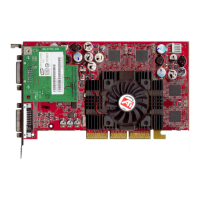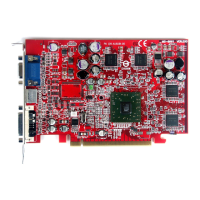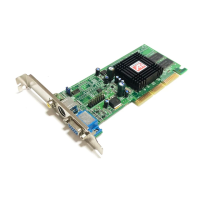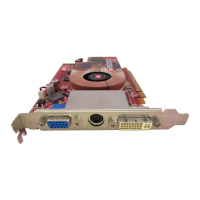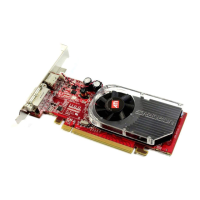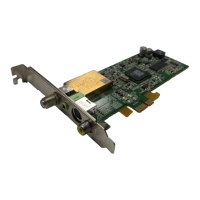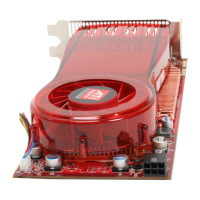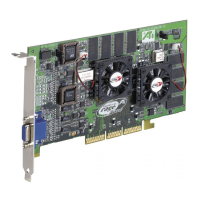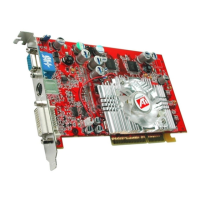
Do you have a question about the ATI Technologies Radeon 9600 PRO and is the answer not in the manual?
| GPU | Radeon 9600 PRO |
|---|---|
| Manufacturer | ATI Technologies |
| Release Date | 2003 |
| GPU Architecture | R300 |
| GPU Codename | RV350 |
| Process Technology | 130 nm |
| Core Clock Speed | 400 MHz |
| Memory Size | 128 MB |
| Memory Type | DDR |
| Memory Clock Speed | 600 MHz |
| Memory Bus Width | 128 bit |
| Memory Bandwidth | 9.6 GB/s |
| DirectX Support | 9.0 |
| OpenGL Support | 2.0 |
| Pixel Pipelines | 4 |
| Shader Model | 2.0 |
| Pixel Shader Version | 2.0 |
| Vertex Shader Version | 2.0 |
| Interface | AGP 8x |
| Max Resolution | 2048 x 1536 |
| Multi-GPU Support | No |
| Vertex Units | 2 |
| Texture Units | 4 |
| ROPs | 4 |
Lists hardware, operating system, and monitor requirements for the graphics card.
Details the available DVI output ports on the graphics card.
Information on README files and direct help within ATI Displays.
Highlights capabilities for 2D/3D graphics and video playback.
Lists advanced 3D graphics capabilities and features.
Explains support for TV Out using an adapter.
Instructions on how to launch the ATI Displays control panel software.
Shows current display settings for the display.
Presents information on the graphics card and driver installed.
Provides a link to ATI Technologies' web site.
Offers advanced functionality and control over the display.
Allows display rotation using hardware acceleration.
Controls display output size without affecting desktop resolution.
Configures advanced display settings like single display operation and hot plug detection.
Settings for Digital Flat Panels, including scaler and frequency reduction.
Allows overriding OpenGL graphics options for specific applications.
Steps to add an application to the Application Profile list.
How to select or create custom OpenGL presets.
Explains how to enable TV output features.
Configures TV output standards (NTSC/PAL) and options.
How to optimize TV display by adjusting video out preferences.
Adjusts sharpness, anti-flicker, brightness, contrast, hue, and saturation.
Adjusts aspect ratio, overscan, and display position for TV output.
Configures control panel startup, window behavior, and exit options.
Accesses additional information within the ATI Displays control panel.
Explains how to use the card for accelerated DVD and QuickTime playback.
Lists supported display resolutions and maximum refresh rates.
Details supported resolutions and example products for DVI connections.
Instructions on how to register the product with ATI.
Details contact methods, availability, language, and access for customer support.
Details FCC rules and conditions for product operation.
States compliance with Canadian ICES-003 standards.
Information regarding Waste Electrical and Electronic Equipment compliance.
Defines "two dimensional" graphics and applications.
Defines "three dimensional" graphics and modeling.
Defines "Apple Display Connector" and its function.
Explains alpha blending for transparency effects in 3D graphics.
Technique preserving surface details at a distance using texture maps.
Method for smoothing jagged edges of curved objects.
Proportions of a display, expressed as width-to-height ratio.
Offscreen memory used for smooth video and graphics acceleration.
Filtering method reducing blockiness when zooming into 3D surfaces.
Number of bits per pixel determining color information capacity.
Graphic or character representation composed of individual pixels.
Amount of white or black applied to colors, affecting perceived lightness.
Portions of on-board video memory used for display and rendering.
ATI's programmable Vertex Shader pipeline for 3D effects.
Red, Green, and Blue components combining to determine pixel color.
Adjusts discrepancies between real color value and screen display.
Represents intensity values for color components for display mapping.
Acronym for "cathode ray tube", a display technology component.
Graphics technique mixing adjacent colors for smooth transitions.
DVI connection transmitting twice the pixel data for higher resolutions.
Specifies monitor display sharpness based on sub-pixel distance.
Acronym for "Digital Video Interface", a standard video connection.
Lighting technique shading polygons based on light source and angle.
Term for blending objects with a fixed color to show distance.
Video memory buffer storing the image being displayed.
Rate at which the graphic processor renders new screens per second.
Correction applied to display for gradual brightness changes.
Shading method producing smooth lighting effects on 3D objects.
Specific color within the visible spectrum, defined by dominant wavelength.
Decreases frame buffer information for better resolutions and 3D acceleration.
Animation technique where start/end points (keyframes) are picked for smooth transitions.
Optimizes storage of buffer regions for rapidly changing 3D data.
Refers to aspects and quality of the virtual light source in 3D graphics.
Simulates decreasing detail in distant objects using lower resolution texture maps.
Analog television signal standard used in Americas (except Brazil) and Japan.
Memory area used to preload images for quick drawing to the screen.
Industry standard for cross-platform 3D graphics development.
Video broadcast standard used in much of Europe and Asia.
Refers to arithmetic units available for rendering output on a display.
The smallest indivisible unit of a digital image, representing a single color dot.
ATI technology using parallel pipelines for advanced texturing.
Rate at which a monitor redraws the screen from top to bottom.
Final drawing stages where 2D image is derived from 3D descriptions.
Number of pixels depicted on screen, specified by horizontal rows and vertical columns.
Intensity of a specific hue (color), vivid vs. grey.
Metal plate in CRT monitors focusing electron beams for image display.
ATI's shader technology for custom transform and lighting effects.
ATI technology supporting high-quality anti-aliasing modes for 3D graphics.
Bright, intense light reflection from a 3D surface, indicating surface properties.
3D equivalent of a pixel, describing the base unit of a 3D object's surface.
Technology reducing EMI and improving digital signals for flat panel displays.
Sampling method producing realistic 3D objects by averaging mipmap levels.
ATI technology enabling accelerated display rotation and scaling.
Graphics processing function manipulating vertex data for realistic 3D effects.
Common analog video connector, also refers to 640x480 resolution mode.
Video memory tracking onscreen elements and their visibility in 3D images.

